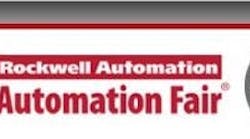“This is our first Process Solutions User Group meeting since the release of PlantPAx 4.0 in March, and we’re seeing how it’s improving automation productivity and time to market by being easier to design, develop and maintain,” said Jason Wright, PlantPAx business manager, Rockwell Automation. “We’re offering a lot of new content on PlantPAx system design and deployment, application development, defining and sizing systems, as well as implementation, administration and maintenance.”
The Process Solutions User Group (PSUG) conference kicked off November 7 in Atlanta, Georgia with a keynote presentation of session and technology highlights.
News and information fell generally into three key areas. “First, there’s a lot to learn,” Wright said. Studio 5000 Architect now includes a library of prebuilt automation strategies, and the ability to build your own, click by click, where needed. Sessions highlight Application Code Manager for automation productivity, how to manage automation investments with FactoryTalk AssetCentre, converting legacy DCS and PLC-5 systems to the PlantPAx modern distributed control system, and executing a successful alarm management project.
[sidebar id =1]Second, “IT/OT convergence is accelerating, so we’re showing how you can adopt the latest IT in your facility,” Wright said, for example, with Stratix switches that let you set up “click-by-click network security.
“Third is enhanced control, and how to build more capabilities,” Wright said. For example, for model predictive control (MPC), you can now run a 10x10 matrix on a controller chassis. “And it’s not just about MPC,” he said. Highlights include higher speeds for applications where MPC does not apply, and sessions on critical control and process safety, intelligent motor control, controller-based batching using SequenceManager, and control loop analytics and utilities to simplify programming.
PlantPAx DCS expands capabilities
“It’s all about using digitization to let operators and teams do their jobs better and make better decisions,” said Kris Dorman, PlantPAx business development manager, Rockwell Automation. A major theme is taking advantage of new technologies, like the cloud and analytics.
To further explain, Dorman introduced a panel of four experts, starting with Tony Barrancotta, PlantPAx engineering manager, Rockwell Automation.
“How do you leverage a library to get the right information to the right people? It’s tough. But part of the answer is well-designed faceplates and presentation of parameters,” said Barrancotta. The latest PlantPAx library adds features for area-based security, ergonomic faceplates and advanced visualization including faceplates for PlantPAx MPC and integration with Studio 5000 Architect.
A Process Library Migration Tool gives users a mechanism to transpose their application to the latest version. “We already provide great tools for documentation, and now we’re automating it,” Barrancotta said. The tool minimizes the number of steps, and walks you through the steps to render your application in the latest version.
Rockwell Automation is also allowing more devices to provide information over EtherNet/IP, including motor control centers and instruments to put control and power together, with new objects for Allen-Bradley PowerFlex 6000, PowerFlex 7000 and PowerFlex 755T drives.
“The future is happening now, with new capabilities and new icons—faceplates, visualization and security, all with a look and feel in common with PlantPAx,” Barrancotta said. “We’re now adding process strategies, multi-language support, and integration with Application Code Manager.”
Managing batch the modern way
“You can trace Rockwell Automation’s batch offerings back to Sequentia and PID, and their roots in S88 and batch sequence logic,” said Dan Updyke, product manager, Rockwell Automation. “For batch, digitization is about embracing knowledge and using it to improve operations by putting it in the hands of operators, on any device they use, including smart phones, tablets and web browsers.”
For example, if an operator in the control room sees a valve fault, goes out and finds the valve limit switch needs an adjustment and adjusts it, they used to have to go back to the control room to test it. “Now they can use their phone or tablet to activate the valve and see it operate,” Updyke said. “This adds a lot of efficiency.
“For modern operators—millennials—having this is important. They’ve grown up with tablets and phones. Mobile is natural and native for them, not trackballs and panels with switches. Mobile embraces modern workflows.”
[sidebar id =2]Scalability conventionally means you can use the same package for small and large applications. Now it also means you can integrate as well. For example, SequenceManager moves operations from the batch server into the controller, so you can do sequencing right in the Logix controller, and right-size it to fit the application.
Integration is also coming to the packages themselves. “We’re putting the portfolio together on FactoryTalk,” Updyke said. With FactoryTalk Batch 13, you can have a skid built with SequenceManager, do a field acceptance test (FAT) and validate it, then bring it into the plant and integrate it without having to rewrite the sequence code at the server level. “FactoryTalk Batch just sends the batch parameters to SequenceManager, so there’s no need to revalidate,” he said. “That can save months of time and millions of dollars.”
Progress at the IT/OT front
“IT and OT. What do we ask of it?” asked Matt Crandell, president and CEO, Automation Control Products (ACP), which was recently acquired by Rockwell Automation. “From IT, we ask for a place to store and access data, with security. From OT, we need control, and to visualize and collect data. In the end, we want a way to use that data in the future, to do things better.”
In this context, small data is like a 12-exposure roll of Kodak film in an Instamatic camera. “You take that to your cousin’s wedding, and you’re going to be very careful about what pictures you take, because it costs a lot to get each picture developed,” Crandell said. Big data is like a digital camera: You shoot everything, hundreds of pictures, some good but mostly trash. Then you go home and sort them out.
“We do this because we can, thanks to Moore’s Law,” Crandell said. “Solid-state drives are doubling in size and speed every two years. But all this data is useless without an application.”
For example, Google sends camera cars everywhere, takes millions of pictures and puts them all in an application: Google Maps. Then you use GPS to get just the data you need, where and when you need it, for example, to avoid a traffic jam and save two hours of commuting time.
“ThinManager is an application for getting the right information to the right people at the right time. It knows who you are, and where you are, and can help you get the right outcomes through better decisions,” Crandell said. And with security: it won’t let you see the data unless you’re the right person, and through geofencing, in the right place.
Bring and keep it together
Rockwell Automation Connected Services build on these technologies with consulting services and pre-engineered solutions. “We can assess the state of your network, then design and deploy what you need. We can house an industrial data center (IDC) and industrial area network (IAN) solution at your facility, and you can pay for it as a service,” said Angela Rapko, North America business manager, Connected Services, Rockwell Automation. “We can provide tech support to monitor and manage your network, provide backup and restore capabilities, and do cache management in one multi-year contract paid on an annual basis.”
A Managed Anomaly Detection Service can monitor and provide security against internal and external threats, and “We’re piloting analytics services including predictive technologies—the technology and people to examine, for example, historian and downtime data,” Rapko added. “We’ll tell you when something is going to break before it happens.”
[sidebar id =3]

Leaders relevant to this article:




